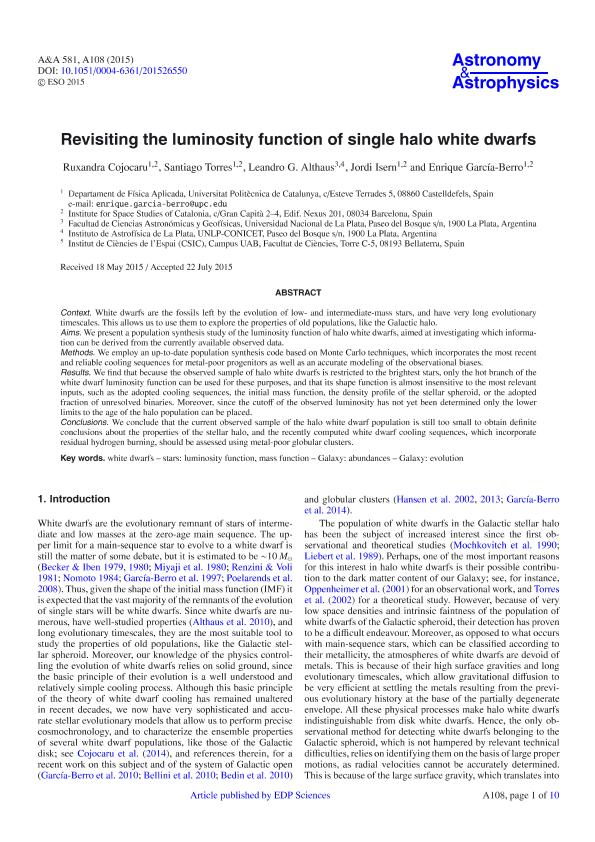Mostrar el registro sencillo del ítem
dc.contributor.author
Cojocaru, Ruxandra
dc.contributor.author
Torres, Santiago
dc.contributor.author
Althaus, Leandro Gabriel

dc.contributor.author
Isern, Jordi
dc.contributor.author
García Berro, Enrique
dc.date.available
2017-01-03T17:13:10Z
dc.date.issued
2015-09
dc.identifier.citation
Cojocaru, Ruxandra; Torres, Santiago; Althaus, Leandro Gabriel; Isern, Jordi; García Berro, Enrique; Revisiting the luminosity function of single halo white dwarfs; Edp Sciences; Astronomy And Astrophysics; 9-2015
dc.identifier.issn
0004-6361
dc.identifier.uri
http://hdl.handle.net/11336/10750
dc.description.abstract
White dwarfs are the fossils left by the evolution of low-andintermediate-mass stars, and have very long evolutionary timescales.This allows us to use them to explore the properties of old populations,like the Galactic halo. We present a population synthesis study of theluminosity function of halo white dwarfs, aimed at investigating whichinformation can be derived from the currently available observed data.We employ an up-to-date population synthesis code based on Monte Carlotechniques, that incorporates the most recent and reliable coolingsequences for metal poor progenitors as well as an accurate modeling ofthe observational biases. We find that because the observed sample ofhalo white dwarfs is restricted to the brightest stars only the hotbranch of the white dwarf luminosity function can be used for suchpurposes, and that its shape function is almost insensitive to the mostrelevant inputs, like the adopted cooling sequences, the initial massfunction, the density profile of the stellar spheroid, or the adoptedfraction of unresolved binaries. Moreover, since the cut-off of theobserved luminosity has not been yet determined only lower limits to theage of the halo population can be placed. We conclude that the currentobserved sample of the halo white dwarf population is still too small toobtain definite conclusions about the properties of the stellar halo,and the recently computed white dwarf cooling sequences whichincorporate residual hydrogen burning should be assessed usingmetal-poor globular clusters.
dc.format
application/pdf
dc.language.iso
eng
dc.publisher
Edp Sciences

dc.rights
info:eu-repo/semantics/openAccess
dc.rights.uri
https://creativecommons.org/licenses/by/2.5/ar/
dc.subject
White Dwarfs
dc.subject
Stellar Populations
dc.subject
Abundances
dc.subject
Evolution of Galaxies
dc.subject.classification
Astronomía

dc.subject.classification
Ciencias Físicas

dc.subject.classification
CIENCIAS NATURALES Y EXACTAS

dc.title
Revisiting the luminosity function of single halo white dwarfs
dc.type
info:eu-repo/semantics/article
dc.type
info:ar-repo/semantics/artículo
dc.type
info:eu-repo/semantics/publishedVersion
dc.date.updated
2017-01-02T18:36:58Z
dc.journal.pais
Francia

dc.journal.ciudad
Paris
dc.description.fil
Fil: Cojocaru, Ruxandra. Universidad Politecnica de Catalunya; España. Institute for Space Studies of Catalonia; España
dc.description.fil
Fil: Torres, Santiago. Universidad Politecnica de Catalunya; España. Institute for Space Studies of Catalonia; España
dc.description.fil
Fil: Althaus, Leandro Gabriel. Consejo Nacional de Investigaciones Científicas y Técnicas. Centro Científico Tecnológico La Plata. Instituto de Astrofísica de La Plata; Argentina. Universidad Nacional de la Plata. Facultad de Ciencias Astronómicas y Geofísicas; Argentina
dc.description.fil
Fil: Isern, Jordi. Universidad Politecnica de Catalunya; España. Institute for Space Studies of Catalonia; España
dc.description.fil
Fil: García Berro, Enrique. Universidad Politecnica de Catalunya; España. Institute for Space Studies of Catalonia; España
dc.journal.title
Astronomy And Astrophysics

dc.relation.alternativeid
info:eu-repo/semantics/altIdentifier/doi/http://dx.doi.org/10.1051/0004-6361/201526550
dc.relation.alternativeid
info:eu-repo/semantics/altIdentifier/url/http://www.aanda.org/articles/aa/abs/2015/09/aa26550-15/aa26550-15.html
Archivos asociados
